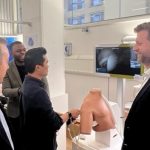In this blog post, targeted at our medical and physiotherapy colleagues, Mr James White, Consultant Shoulder and Elbow Surgeon discusses this potentially devastating injury. A complex case recently treated by Mr White is presented. Please let us know if you find these posts useful – we hope they are educational and stimulate discussion and learning.
What is a radial head fracture?
A fracture or break or a bone generally occurs secondary to trauma, commonly from a fall from a standing height , but in some cases with more velocity associated. Radial head fractures affect the most proximal part of the radius, a bone which runs the length of the forearm from elbow to the wrist. The radial head disc shaped and intra-articular as it articulates with the capitellum of the distal humerus. It is, of course part of the elbow joint. It is mainly involved in rotation, which is vital for elbow function. A more detailed description of elbow anatomy and biomechanics can be found, for free, here. These fractures can be simple two part fractures, but in some instances the bone can fracture in multiple places.
What are the symptoms?
Patients develop immediate pain and swelling and can also have loss of range of movement of the elbow. There can be associated damage and dislocation of the radius and ulna in relation to the humerus, and also associated nerve injuries.
How is it diagnosed?
It is diagnosed by taking a careful history and performing a detailed examination. There are also other associated injuries of bones in the elbow, forearm, or wrist, which the clinician will carefully exclude. Rotation of the forearm is an essential assessment so called ‘supination or pronation’. Assessment will be made to ensure that the associated nerves and vessels have not been injured. X-ray, and CT imaging in selected cases, can be useful to exclude other potential injuries and to further assess the fracture particularly in cases where surgical management is required. The investigations will help to inform the clinician and patient regarding this.
How is it treated?
Treatment begins with symptomatic management with pain killers, and the use of a sling or for support. The displacement of the fracture, the location and the degree of trauma associated help to guide the patient and clinician with regards to the need for surgery. The demands of the patient both for their occupation and for sporting activities are a key component of making this decision.
Non Surgical Treatment Options:
Radial head fractures not associated with a dislocation with minimal displacement can be mobilised early to allow full range of movement and allow the bone to heal in an acceptable position. At Grosvenor orthopaedics we aim to avoid the use of elbow immobilisation in plasters as elbow injuries can lead to long term stiffness if not rehabilitated early. This allows for the best chance of achieving full range of movement in radial head fractures, allowing for early range of movement.
Surgical Treatment Options:
Radial head fractures in multiple parts and with significant displacement leading to a block in rotation, or associated with significant elbow instability, will require operative intervention. Surgical reconstruction with open fixation with headless compression screws can lead to excellent patient outcomes. For un-reconstructable radial head fractures, radial head replacement can be necessary. Radial head replacements can be either fixed with cement or bony compression or some designs aim for a loose fixation. These replacements are not uncommonly required in young patients. It is therefore paramount that they are placed correctly to allow full range of movement and prevent the need for early revision.
We aim to provide our patients with the most predictable and earliest return to work and sporting activities by making the most appropriate and evidence based decisions possible. When combined with postoperative physiotherapy, an essential to ensure surgical success, this leads to decreased pain, improved range of movement and long term functional gain. For those interested the fine detail of these injuries, we suggest following this link for free access to an excellent review paper.
Case Study: Combined Radial Head and Ulna Fracture:
One young patient presented to my care during lockdown with a complex fracture of his radial head. This was sustained following a fall from a bicycle and represented a high velocity injury.The radial head was significantly displaced. The fracture was also associated with a dislocation and fracture of the ulna, which is called a ‘Monteggia’ fracture.

CT scan was essential for operative planning. I considered the radial head salvageable, despite displacement of both fragments and associated instability.




The surgery aimed to restore stability to allow early range of movement exercises on day 1, as I aim with all of my elbow patients. This reduces the risk of stiffness and loss of function.Combined with regular postoperative physiotherapy we were able to achieve full range of movement and healing of both radius and ulna. `The patient has also been able to return to his original sporting activities
Patient Review:
“Further to a bicycle accident I had in May 2020, I required elbow surgery and underwent a right radial head and ulna fixation under the expert care of Mr W James White. I am not medical professional but can confirm that the injury I sustained was somewhat bad and that there was a risk that I may not regain full functionality of my right arm. Before my operation, Mr White took time to explain what he planned to do and what was his ultimate objective during surgery. Fast forward, 4.5 hours of surgery time, Mr White came to see me in my hospital room, obviously checked if I was ok, advised me that surgery when exceptionally well and what to do before my scheduled appointment to see him in 10 days’ time. Furthermore, the next morning two of his team members came to see me, reiterated what Mr White had told me post-surgery the previous day and echoed how successful the operation had been. At my 10 day follow up appointment with Mr White, only then I was able to appreciate the full extent of my injury and subsequently magnitude of the miracle he had performance – complete masterpiece. He also explained, to get close to full functionality what will be required and equally it was going to take time. Throughout my rehabilitation, whenever my physiotherapist had any questions for Mr White in order expedite my rehab (where possible and safe to do so), Mr White always promptly responded with fail. You will not be surprised to hear that under the proficient care of Mr White, in less the 6 months since having surgery, I have made a full recovery in terms of extension, flexion, mobility and functionality. I am back in the gym, boxing, playing golf all subject to covid restrictions. I was very fortunate to have Mr White as my Orthopaedic Surgeon and cannot thank him enough for ultimately saving my arm, you are a true superhero in my mind.”
To find out more about Mr James White please visit his profile, or book in to see him at one of his many clinic locations across London.







